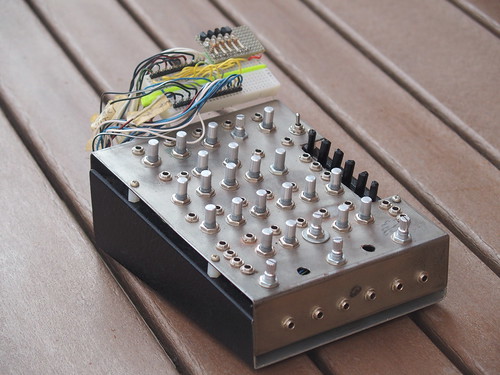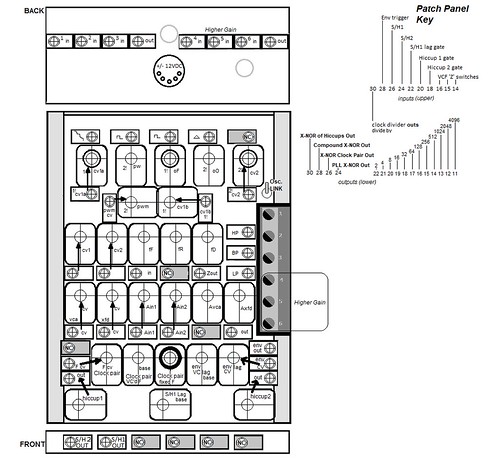The Offshore
I make a great deal of noise about my allegiance to DIY instruments but real-life is gray-area! And one of those facts of life is that there are commercial instruments out there that meet my needs and scratch my itches. But I often buy them and a wish list immediately emerges for every feature that they DON’T have. The Offshore is one of those wish-lists. It’s name is a riff on the commercial synth it was conceived to augment. The ‘Zero-Coast‘ by MakeNoise/Tony Rolando, (Get-it? zero-COAST, offSHORE) which is a terrific little micro modular system on it’s own. But I never leave well-enough alone and so I set to work on all the extras I wanted.
-2 mixers
-a voltage controlled crossfader & VCA
-3 complex stepped & smooth random control voltage generators
-a ‘EDP Wasp‘-style CMOS-based state-variable VCF
-a very complex intermodulated VCO pair (topic expanded below)
I have a fetish for the power of paired VCO’s. When you have two waves you get a wonderful two-fer. Namely an INTERVAL! (so… with waves. 1+1 actually equals 3(!) & sometimes MORE than 3!) The big idea for this device was Metal. That’s why it’s almost all burnished silver & black. And a VCO pair is a rollicking formula for ‘der Klang machen’.
A block diagram for this VCO pair is below. It is very abbreviated & simplified in order to clarify the signal flow. To wit: There are two pulse wave VCOs that respond to a control voltage in different curves*. So even if they happen to be in unison at a particular voltage, that interval will widen and narrow as the control voltage changes. The net effect is that, even sharing the same control voltage, the two VCOs will effectively never be in tune, and their out-of-tune-ness is not uniform. It will vary over the entire range of control. One of the VCOs also features a voltage controlled pulse width. This provides a very expanded means of manipulating phase. At the next stage I feed the two pulse waves into two different types of comparator-processes. One is a standard logic gate, an XOR. The other is a fancy circuit that compares the rising edge of the pulse waves at each of its two inputs. And if those edges line up, the output stays low but if they don’t line up (which they almost never do in this circuit) it outputs a stream of pulses that get denser the farther out of alignment the two edges are. I then feed this stream into the data input of a 3-bit shift register and use the XOR output as a sputtering unsteady clock. Then I turn the shift register’s output patterns into a very actively varying staircase wave with a DAC.
(whew!) It’s quite a Rube Goldberg scheme.
The output sounds very metallic with nonharmonic overtones that are always shifting. And since this complex wave is derived by comparing derivations of the two VCO frequencies the final output frequency is always lower than the VCO frequencies so the VCOs have to be very wide-range .
Another clangorous metallic-sounding choice was a deliciously raspy CMOS-based VCF circuit modeled on the VCF circuit used in the British punk-era analog classic, the EDP Wasp, to which I added an output that randomly switches among combinations of the low, high, & band pass outputs.
The control voltage generators on the device had a lot of potential gate points that could be interconnected to configure behaviors, but would not need to be manipulated often. So I decided to deploy a breadboard as a patch-panel as in the Bell-Jar. This is the messy bit at the top of the device in the top photo.
And last, but not least, that metal box it’s in! Electric guitarists are likely to recognize the enclosure. It is a recycled Big Muff Pi fuzz box. I ‘raised the roof’ a bit to allow for better ventilation. The original fuzz box circuit had about 4 dozen components in it. Now this same box is home to about 1200 components so there’s bit of heat generated. Plus, one of the many great advantages to working with the clear acrylic enclosures I usually use is that they don’t conduct electricity. So an accidental contact between the box and the circuit board is harmless. But this box is steel; and it seemed downright anxious to cause a short. So the extra room provided by the gaps gave me a little insurance against an accidental contact.
*this was accomplished by using one VCO that uses a conventional control scheme, while the other VCO is controlled by an optical coupler (called a Vactrol) which does not follow the same curve as a conventional VCO



Comments are closed.